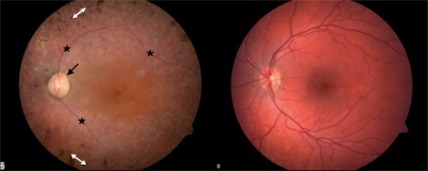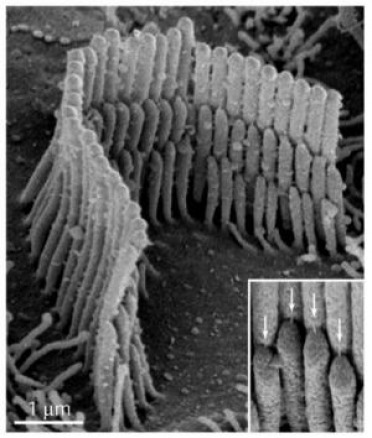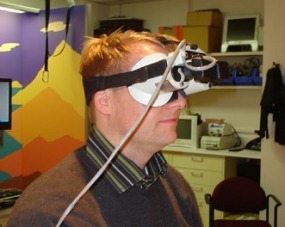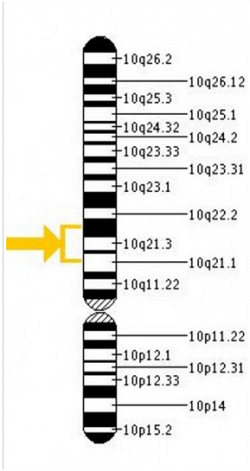This web page was produced as an assignment for Genetics 677, an undergraduate course at UW-Madison
What Is Usher Syndrome?
Usher Syndrome (USH) is a universal genetic disorder characterized by the dual loss of audio and visual sensory function. Among all of the "dual sensory" impairment diseases (about 50 exist), USH is responsible for half of their victims.
Usher Syndrome can be classified into three subtypes, defined on varying degrees of vestibular degradation. In USH1, victims experience profound hearing loss with virtually no inner ear function. USH2, the second most advanced subtype, is found in about half of all Usher Syndrome victims. USH2 is characterized by moderate to severe hearing loss, with some vestibular function present. The final USH variant, subtype 3, is a rare subtype characterized by progressive gradual degradation of vestibular function, e.g. hearing loss. Curiously, it is rarely found in most populations, but in two distinct populations, Finlandians and Ashkenazi Jews Within these populations USH3 can account for up to 40% of USH cases. This fact presupposes the idea that the varying degree of Usher Syndrome could have genetic components, and may not be based on the stage of the disease itself, as a function of time. (Saihan Z, 3009)
Usher Syndrome can be classified into three subtypes, defined on varying degrees of vestibular degradation. In USH1, victims experience profound hearing loss with virtually no inner ear function. USH2, the second most advanced subtype, is found in about half of all Usher Syndrome victims. USH2 is characterized by moderate to severe hearing loss, with some vestibular function present. The final USH variant, subtype 3, is a rare subtype characterized by progressive gradual degradation of vestibular function, e.g. hearing loss. Curiously, it is rarely found in most populations, but in two distinct populations, Finlandians and Ashkenazi Jews Within these populations USH3 can account for up to 40% of USH cases. This fact presupposes the idea that the varying degree of Usher Syndrome could have genetic components, and may not be based on the stage of the disease itself, as a function of time. (Saihan Z, 3009)
Retinal Discoloration in Usher Syndrome

The retinas of a victim of RP (left) and a normal human (right). The optic nerve is relatively discolored and capillary presence is reduced in the RP victim's retina as tunnel vision sets in. (Saihan Z, 2009)
http://www.ushersyndrome.nih.gov/whatis/fulltext.html
http://www.ushersyndrome.nih.gov/whatis/fulltext.html
Usher Syndrome can also have stunning effects in terms of visual impairment. In all subtypes of USH, victims usually develop an eye disorder called retinitis pigmentosa (RP). Vision loss originates at the peripheral rods and progresses inwards, creating tunnel vision. (Bork et al., 2001)
Videonystamemography Determines Retinal Pigmentosa, a symptom of Usher Syndrome
Cadherin 23 and it's Prevelance to Usher Syndrome

http://www.sciencedaily.com/images/2006/06/060627173613.jpg
Cadherin 23 (CDH23), a gene whose mutations have been closely linked to Usher Syndrome, is responsible for the production of the cadherin 23 protein. Cadherin 23 is a membrane protein found in both inner ear cells and retinal cells. Depending on the specialized cell, different versions of the protein are made, with a longer version of the protein cut in inner ear cells. Cadherin 23 assembles a protein complex through interaction with other membrane-bound proteins, and this complex is involved in cell-cell adhesion. (CDH23. Genetics Home Reference)
Reserch has shown that such protein complexes, within the inner ear, cause formation of hair bundles: inner ear members composed of stereocilia (see left image). Stereocilia are seen as the primary receptors of sound wave. As sound waves enter the inner ear, they cause stereocilia to bend, which initiates a signal pathway resulting in a nerve impulse. This process is a requisite for normal hearing.
Less is known with regard to cadherin 23's role in retinal cells. The protein has been found in rod and cone retinal cells, and this suggests a potential role of the protein in the function of these cells. (Saihan et al. 2009)
Reserch has shown that such protein complexes, within the inner ear, cause formation of hair bundles: inner ear members composed of stereocilia (see left image). Stereocilia are seen as the primary receptors of sound wave. As sound waves enter the inner ear, they cause stereocilia to bend, which initiates a signal pathway resulting in a nerve impulse. This process is a requisite for normal hearing.
Less is known with regard to cadherin 23's role in retinal cells. The protein has been found in rod and cone retinal cells, and this suggests a potential role of the protein in the function of these cells. (Saihan et al. 2009)
A rough gene map locating cadherin 23
My research aims to compare wild-type and pathogenic mutant cadherin 23
precursor proteins, found in the auditory pathway, in an attempt to identify
the domains or amino acids required for normal cdh23 function. For
proposed hypothesis and experimental design, see the
Experiment and future directions page.
precursor proteins, found in the auditory pathway, in an attempt to identify
the domains or amino acids required for normal cdh23 function. For
proposed hypothesis and experimental design, see the
Experiment and future directions page.
Who's Been Here?
Please help the fight against Usher Syndrome. Visit: http://www.ushernet.org/en/charity/index.html
References
Background on Disease:
1. Saihan, Zubin; Webster, Andrew R; Luxon, Linda; Bitner-Glindzicz, Maria (2009) Updated on Usher Syndrome. Current Opinion in Neurology. 1:19-27
2. "Usher Syndrome". NIH website: http://www.ushersyndrome.nih.gov/whatis/fulltext.html
3. Bork JM et al. (2001) Usher Syndrome 1D and Nonsyndromatic Autosomal Recessive Deafness DFNB12 Are Caused by Allelic Mutations of the Novel Cadherin-Like Gene CDH23. Am. J. Hum. Genet. 68:26-37.
Background info on gene:
4. CDH23. Genetics Home Reference. http://ghr.nlm.nih.gov/gene=cdh23
Gene info:
5. NCBI. http://www.ncbi.nlm.nih.gov/gene/64072?
Background on Disease:
1. Saihan, Zubin; Webster, Andrew R; Luxon, Linda; Bitner-Glindzicz, Maria (2009) Updated on Usher Syndrome. Current Opinion in Neurology. 1:19-27
2. "Usher Syndrome". NIH website: http://www.ushersyndrome.nih.gov/whatis/fulltext.html
3. Bork JM et al. (2001) Usher Syndrome 1D and Nonsyndromatic Autosomal Recessive Deafness DFNB12 Are Caused by Allelic Mutations of the Novel Cadherin-Like Gene CDH23. Am. J. Hum. Genet. 68:26-37.
Background info on gene:
4. CDH23. Genetics Home Reference. http://ghr.nlm.nih.gov/gene=cdh23
Gene info:
5. NCBI. http://www.ncbi.nlm.nih.gov/gene/64072?
Ben Hofeld, [email protected], last updated: 5.15.2010, Link to course page:www.gen677.weebly.com


